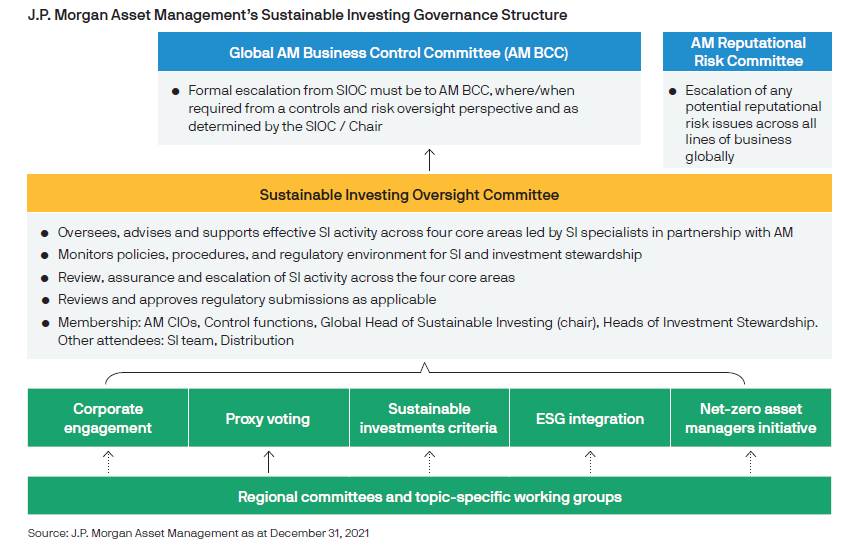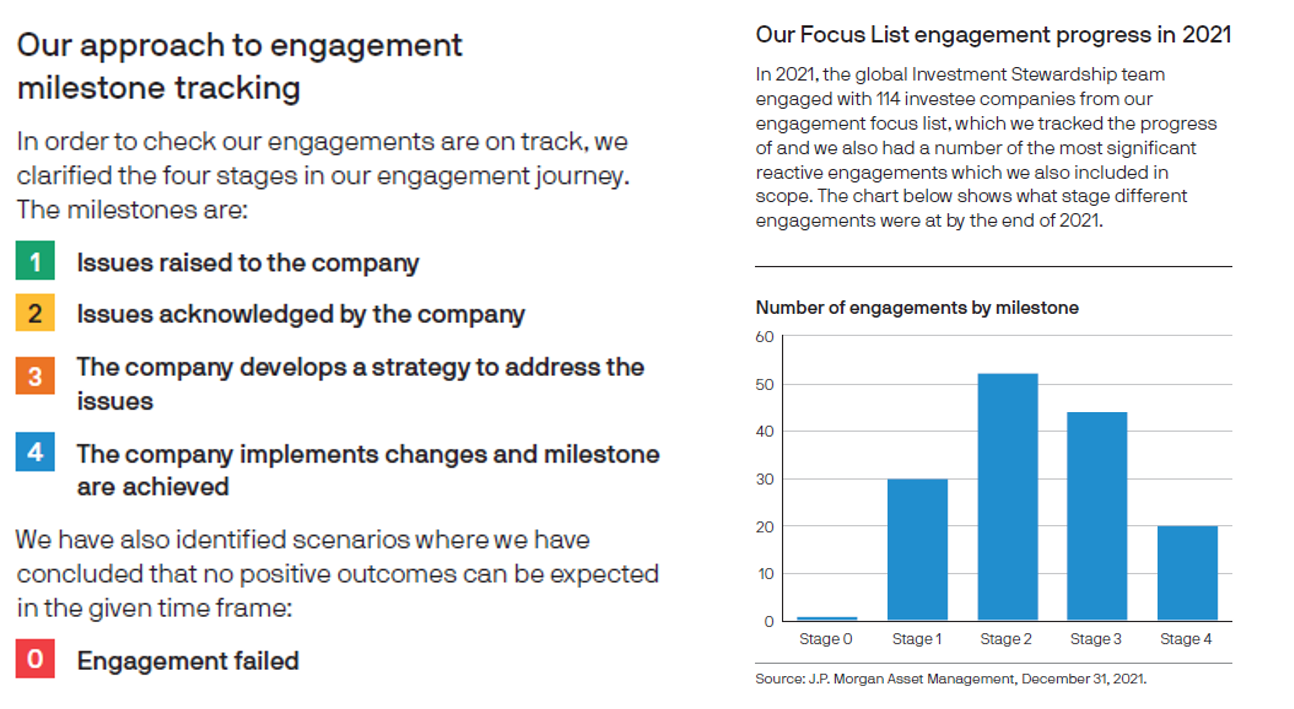J.P. Morgan Asset Management: Continual engagement strategies
"Generally, it can take several years before our engagements yield tangible results; we expect an engagement timeframe of about three years before our milestones are achieved."
J.P. Morgan Asset Management
17 June 2022
J.P. Morgan Asset Management is the brand name for the investment management businesses of JPMorgan Chase & Co. and its affiliates worldwide, overseeing more than USD2.65 trillion in client assets under management globally as of 31 December 2021. Our purpose is to deliver outstanding investment performance to help our clients achieve better long-term outcomes. As part of our fiduciary duty to act in the best interest of our clients, we are passionate about offering a global depth and breadth of investment solutions supported by dedicated market experts and continual reinvestment in tools, technology and operational excellence. Our aim is to empower better investment decisions by providing investment insights that tap into over 150 years of investment experience.
Through a research-driven culture dedicated to collaboration, client service and active innovation, we seek to deliver stronger financial outcomes by focusing on the most critical ESG issues that impact the performance of companies in which we invest on behalf of our clients. We advocate for robust corporate governance and the sound and sustainable business practices core to long-term value creation for our clients.
Sustainable Investing Oversight Committee
The governance of stewardship activities is overseen by our Sustainable Investing Oversight Committee (SIOC). Committee members include the Chief Investment Officers (CIOs) of each asset class alongside the Global Head of Sustainable Investing, the Global Head of Investment Stewardship and heads of control functions such as risk and compliance. SIOC serves as a single point of ongoing strategic oversight, effective decision-making, review and assurance across the key components of sustainable investing. This includes engagement, proxy voting, sustainable investing criteria, oversight of ESG integration, oversight and review of implementation plans for the firm’s commitment to Net Zero Asset Managers Initiative, as well as regulatory developments. Related policies, programmes, targets and performance are overseen by this group. It meets on a quarterly basis.

Stay active through constructive and purposeful engagement (SSP Principle 3)
J.P. Morgan Asset Management has taken an investor-led, expert-driven approach for investment stewardship. We actively engage with investee companies, exercise our voice as a long-term investor in industry participation and proxy voting. We take into account the latest stewardship codes expectations to monitor the effectiveness of the engagements.
Our engagement is based on the following building blocks:
• Intentionality: We are determined to act in the best interests of our clients by encouraging investee companies to focus on responsible allocation of capital and long-term value creation.
• Materiality: We strive to understand how factors impacting sustainability are financially significant to companies over time, understanding that the regions, cultures and organisations in which we invest differ greatly.
• Additionality: We focus on strategic issues that are most urgently in need of our involvement to alter the status quo. We believe that as large investors, we have the ability to put our resources to work in a way in which they can move the needle and achieve the outcome we set out to do. It is not a box-ticking exercise.
• Transparency: We have to be clear about the stewardship work we do and take steps to be transparent to our stakeholders as we expect the same of investee companies.
Following a review of our engagement approach in 2021, we implemented an approach to tracking engagement progress and recording milestones where objectives have been achieved. The aim is to make sure our engagements are impactful and investee companies are responding in a constructive fashion over time. It also allows us to identify areas where progress is slow and to enable constant improvement of our engagement methodology and framework to achieve better outcomes.
The Focus List
In 2021, we put in place the engagement progress tracking system for a subset of our engagements — the Focus List, where the most intensive dialogue is taking place with investee companies. We plan to expand the scope in 2022.
We identify ESG issues at investee companies held in our portfolios and then initiate our engagement by discussing our concerns with companies and subsequently asking them to take action. In most cases, engagement can take time to progress. It takes time before the board or management acknowledges an issue and start to implement a roadmap of action to deliver meaningful change. Sometimes, our engagement asks can require structural and organisational changes that are not easy or quick to achieve. Generally, it can take several years before our engagements yield tangible results; we expect an engagement timeframe of about three years before our milestones are achieved. 
In 2021, we observed that companies are quicker to address investor concerns over remuneration (included in our engagements on strategy alignment with the long term). When asked to change structures to align pay and mid-to-long-term performances or to introduce sustainability criteria, they have tended to be reflected in remuneration proposals at the shareholder meeting in a shorter timeframe.
We have also observed that in our engagements on themes related to human capital management and stakeholder engagement, where we address diversity and cybersecurity, companies seem to be adopting steady changes as most companies tend to share awareness and take action to improve the level of disclosures. However, for climate risk, even though companies acknowledge the issue as material, formulating strategies to achieve ambitious targets can take more time. This issue is described in the engagement case studies section of the global annual stewardship report in more detail. With regards to governance, we found it is sometimes problematic to find common ground with companies on the theme of capital allocation in particular, where we note there has been one case of engagement failure.
Report stewardship activities periodically (SSP Principle 6)
We publish an annual global stewardship report which is available on our websites.
The report provides a regular update on our stewardship activities. We remain continually committed to increasing transparency around our stewardship work, including sharing more information on how we are holding companies to account on key issues when it comes to using our voting power, where appropriate.
J.P. Morgan Asset Management publicly discloses its voting. It is updated on a quarterly basis and contain the voting record, at company level, for all meetings voted globally in the preceding quarter. These reports are available here.
Through active ownership and engagement, J.P. Morgan Asset Management manages ESG risks and systematically incorporate insights gained from engagement into our decisions. This helps us understand how companies or issuers consider issues related to ESG but also enable us to try to influence their behaviour and encourage best practices, for the purpose of enhancing returns for our clients.
“Active ownership is woven into our active management heritage and we constantly evolve our sustainable investing approach to keep pace with the changing requirements of our clients and regulators. The renewed Singapore Stewardship Principles for Responsible Investors (SSP), including monitoring investments regularly, staying active through constructive and purposeful engagement and taking a collaborative approach in exercising stewardship responsibilities, are in line with JPMAM’s approach to stewardship and engagement,” Sherene Ban, CEO of Singapore and Southeast Asia of J.P. Morgan Asset Management said.